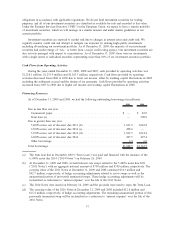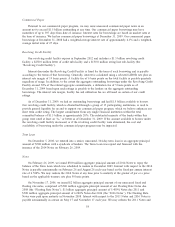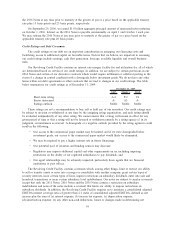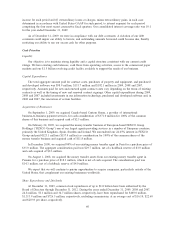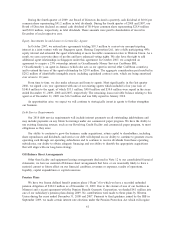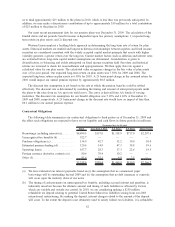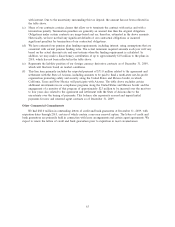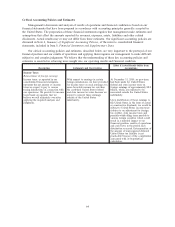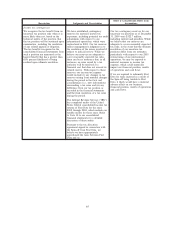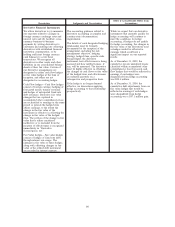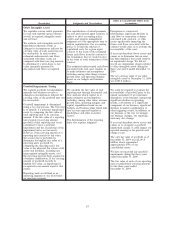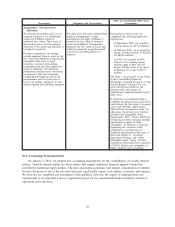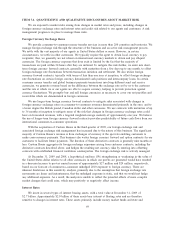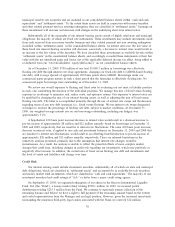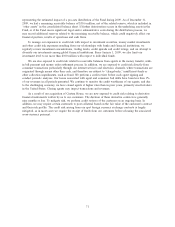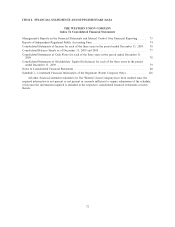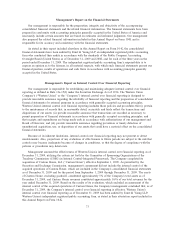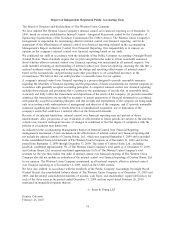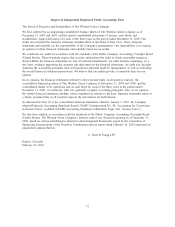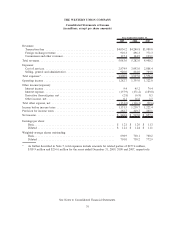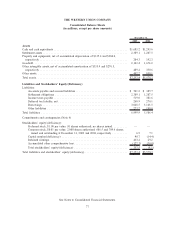Western Union 2009 Annual Report Download - page 81
Download and view the complete annual report
Please find page 81 of the 2009 Western Union annual report below. You can navigate through the pages in the report by either clicking on the pages listed below, or by using the keyword search tool below to find specific information within the annual report.
Description Judgments and Uncertainties
Effect if Actual Results Differ from
Assumptions
Other Intangible Assets
We capitalize certain initial payments
for new and renewed agent contracts
as well as acquired intangible assets
and software.
We evaluate such intangible assets for
impairment whenever events or
changes in circumstances indicate the
carrying value of such assets may not
be recoverable. In such reviews,
estimated undiscounted cash flows
associated with these assets are
compared with their carrying amounts
to determine if a write-down to fair
value (normally measured by
discounted cash flows) is required.
The capitalization of initial payments
for new and renewed agent contracts is
subject to strict accounting policy
criteria and requires management
judgment as to the appropriate time to
initiate capitalization. Our accounting
policy is to limit the amount of
capitalized costs for a given agent
contract to the lesser of the estimated
future cash flows from the contract or
the termination fees we would receive
in the event of early termination of the
contract.
The estimated undiscounted cash flows
associated with each asset requires us
to make estimates and assumptions
including among other things revenue
growth rates, and operating margins
based on our budgets and business
plans.
Disruptions to contractual
relationships, significant declines in
cash flows or transaction volumes
associated with contracts, or other
issues significantly impacting the
future cash flows associated with the
contract would cause us to evaluate the
recoverability of the asset.
If an event described above occurs and
causes us to determine that an asset
has been impaired, that could result in
an impairment charge. We did not
record any impairment charges related
to other intangible assets during the
three year period ended December 31,
2009.
The net carrying value of our other
intangible assets at December 31, 2009
was $489.2 million.
Goodwill Impairment Testing
We evaluate goodwill for impairment
annually and whenever events or
changes in circumstances indicate the
carrying value of the goodwill may not
be recoverable.
Goodwill impairment is determined
using a two-step process. The first step
is to identify if a potential impairment
exists by comparing the fair value of
each reporting unit to its carrying
amount. If the fair value of a reporting
unit exceeds its carrying amount,
goodwill of that reporting unit is not
considered to have a potential
impairment and the second step of the
impairment test is not necessary.
However, if the carrying amount of a
reporting unit exceeds its fair value,
the second step is performed to
determine the implied fair value of a
reporting unit’s goodwill, by
comparing the reporting unit’s fair
value to the allocated fair values of all
assets and liabilities, including any
unrecognized intangible assets, as if
the reporting unit had been acquired in
a business combination. If the carrying
amount of goodwill exceeds its
implied fair value, an impairment is
recognized in an amount equal to that
excess.
Reporting units are defined as an
operating segment or one level below
an operating segment.
We calculate the fair value of each
reporting unit through discounted cash
flow analyses which require us to
make estimates and assumptions
including, among other items, revenue
growth rates, operating margins, and
capital expenditures based on our
budgets and business plans which take
into account expected regulatory,
marketplace and other economic
factors.
The determination of the reporting
units also requires judgment.
We could be required to evaluate the
recoverability of goodwill prior to the
annual assessment if we experience
disruptions to the business, unexpected
significant declines in operating
results, a divestiture of a significant
component of our business, significant
declines in market capitalization or
other triggering events. In addition, as
our business or the way we manage
our business changes, our reporting
units may also change.
If an event described above occurs and
causes us to recognize a goodwill
impairment charge, it could impact our
reported earnings in the periods such
charge occurs.
The carrying value of goodwill as of
December 31, 2009 was $2,143.4
million which represented
approximately 29% of our
consolidated assets.
We have not recorded any goodwill
impairments during the three years
ended December 31, 2009.
The fair value of each of our reporting
units exceeded their carrying amounts
for the three years ended
December 31, 2009.
67


